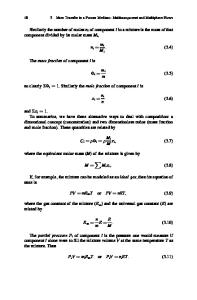Analysis and Modeling of Lithium Flows in Porous Materials
- PDF / 1,690,775 Bytes
- 7 Pages / 612 x 792 pts (letter) Page_size
- 8 Downloads / 365 Views
AMAKS
Analysis and Modeling of Lithium Flows in Porous Materials1 J. Rudolph and G. Miloshevsky* School of Nuclear Engineering, Purdue University, West Lafayette, Indiana, 47907 United States *e-mail: [email protected] Received December 8, 2017
Abstract—One of the primary conditions necessary for the success of magnetic fusion reactors is the ability to mitigate damage to the first wall during ELMs and plasma disruptions. A potential solution involves the use of flowing liquid metals such as lithium as a first wall, but ensuring its stability under the extreme environments in the reactor would be imperative. The conditions leading to instabilities on the free surface of flowing liquid lithium (LL) layers on a substrate and in a porous material are investigated using both analytical methods and computational modeling, with consideration for the effects of LL velocity, LL layer thickness, substrate porosity, LL permeability, and hydrogen (H) plasma velocity. Linear stability analysis is used to predict the critical velocity and wavelength-dependence of wave growth, as well as the onset of instability. The modeling of LL flows is performed on a flat substrate and in a porous material for various LL thicknesses, LL and H plasma velocities to analyze the conditions leading to droplet formation and ejection. DOI: 10.1134/S1063780X1807005X
1. INTRODUCTION Liquid lithium (LL) walls have been identified as a potential solution to many of the engineering problems in a magnetic fusion reactor [1]. The flowing liquid metal could provide heat removal, elimination of erosion via constant renewal of the wall, and possible stabilization of magneto-hydrodynamic (MHD) modes. However, there is a question about the stability of the free surface of a LL. The erosion of the LL surface can be induced by H plasma or lithium (Li) vapor flow pressure or Lorentz forces that may lead to its instability and undesirable effects such as waving, dewetting, and Li droplet ejection [2]. Potential mitigation approaches should be developed to achieve smooth and controllable LL flow in the magnetic field, prevent LL thickness variation and formation of dry spots, and eliminate LL splashing and plasma contamination by LL droplets formed during ELMs or plasma disruptions. A lithium capillary-pore system as a plasma facing component (PFC) was proposed and developed for protection of the divertor plates [3]. For porous structures, the LL stability can be considerably supported by the surface tension forces in capillary channels [4, 5]. The NSTX-U experiments at the Princeton Plasma Physics Laboratory are planned for testing a prefilled LL divertor system with capillary wicking channels for supply of Li from an internal reservoir [6, 7]. The understanding of the underlying physical mechanisms of the LL free surface waving, Li splashing, and droplet ejection is of critical impor1 The article is published in the original.
tance in achieving a controllable LL flow on the solid substrates [8]. A number of experimental and computational studies on the free s
Data Loading...











